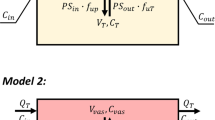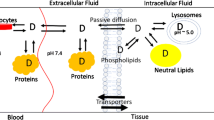Abstract
Purpose. To determine the extent of albumin diffusion from tissue pieces into medium during in vitro incubations, to develop and assess the utility of mathematical models describing this effect on the estimation of tissue-to-unbound plasma partition coefficients (Kpu) of drug substances and to derive factors to correct for associated errors.
Methods. Twelve separate tissues were obtained from rats sacrificed by cervical dislocation, 48 h after an intravenous dose of 125I-human albumin, and tissue pieces incubated to determine the efflux of albumin into media over 2 to 4 h. A mathematical model was developed to predict and correct for the effect of albumin diffusion on the measured Kpu values of drugs.
Results. The model predicted that the effect of albumin diffusion from tissue pieces during in vitro incubation (ranging from 14 to 59% remaining in tissue) on Kpu values was generally minimal, except for compounds that are highly plasma bound and have a low measured Kpu. Under these circumstances, the measured Kpu substantially underestimates the true value. An equation was derived from readily available or measurable parameters to correct for this underestimation.
Conclusions. Albumin diffuses from tissue pieces into protein free media during in vitro incubations until equilibrium is reached, defined by the albumin Kpu. Model predictions indicated that for the majority of compounds albumin diffusion would have a minimal effect on the measured Kpu value and that a correction factor could be calculated to account for any deviation.
Similar content being viewed by others
References
J. L. Gabrielsson, L. K. Paalzow, and L. Nordstrom. A physiologically based pharmacokinetic model for theophylline disposition in the pregnant and nonpregnant rat. J. Pharmacokinet. Biopharm. 12:149–165 (1984).
D. R. Plowchalk, M. E. Andersen, and J. D. DeBethizy. A physiologically based pharmacokinetic model for nicotine disposition in the Sprague-Dawley rat. Toxicol. Appl. Pharmacol. 116:177–188 (1992).
J. E. Murphy, D. B. Janszen, and M. L. Gargas. An in vitro method for determination of tissue partition coefficients on non-volatile chemicals such as 2,3,7,8-tetrachlorodibenzo-p-dioxin and estradiol. J. Appl. Toxicol. 15:147–152 (1995).
V. Fiserova-Bergerova, M. Tichy, and F. J. Di Carlo. Effects of biosolubility on pulmonary uptake and disposition of gases and vapors of lipophilic chemicals. Drug Metab. Rev. 15:1033–1070 (1984).
M. L. Gargas. Chemical-specific constants for physiologically-based pharmacokinetic models. Chem. Ind. Inst. Toxicol. Act. 11:1–12 (1991).
M. H. Bickel and R. Gerny. Drug distribution as a function of binding competition. Experiments with the distribution dialysis technique. J. Pharm. Pharmacol. 32:669–674 (1980).
C. W. Bazil, M. E. Raux, S. Yudell, and K. P. Minneman. Equilibration of halothane with brain tissue in vitro: Comparison to brain concentrations during anaesthesia. J. Neurochem. 49:952–958 (1987).
C. Post, R. G. G. Andersson, A. Ryrfeldt, and E. Nilsson. Transport and binding of lidocaine by lung slices and perfused lung of rats. Acta Pharmacol. Toxicol. 43:156–163 (1978).
P. Ballard, D. E. Leahy, and M. Rowland. Prediction of in vivo tissue distribution from in vitro data. 1. Experiments with markers of aqueous spaces. Pharm. Res. 17:660–663 (2000).
H. M. Pappius and K. A. C. Elliott. Water distribution in incubated slices of brain and other tissues. Can. J. Biochem. 34:1007–1022 (1956).
W. C. Dewey. Vascular-extravascular exchange of 131I plasma proteins in the rat. Am. J. Physiol. 197:423–431 (1959).
J. Katz, G. Bonorris, and A. L. Sellers. Extravascular albumin in human tissues. Clin. Sci. 39:725–729 (1970).
H. M. Pappius, I. Klatzo, and K. A. C. Elliott. Further studies on swelling of brain slices. Can. J. Biochem. 40:885–898 (1962).
D. C. Pang and N. Sperelakis. Nifedipine, diltiazem, bepridil and verapamil uptakes into cardiac and smooth muscles. Eur. J. Pharmacol. 87:199–207 (1983).
L. S. Schanker and A. S. Morrison. Physiological disposition of guanethidine in the rat and its uptake by heart slices. Int. J. Neuropharmacol. 4:27–39 (1965).
J. Crank. The Mathematics of Diffusion. Clarendon Press, Oxford, 1967.
T. Peters Jr. Serum albumin, in The Plasma Proteins. Structure, function, and genetic control (F. W. Putnam, ed.). Academic Press, New York, 1975.
G. E. Blakey, I. A. Nesterov, P. A. Arundel, L. J. Aarons, and M. Rowland. Quantitative structure pharmacokinetics relationships: 1. Development of a whole-body physiologically based model to characterize changes in pharmacokinetics across a homologous series of barbiturates in the rat. J. Pharmacokinet. Biopharm. 25:277–312 (1997).
P. Ballard, D. E. Leahy, and M. Rowland. Prediction of in vivo tissue distribution from in vitro data. 3. Correlation between in vitro and in vivo tissue distribution of a homologous series of nine 5-n-alkyl-5-ethyl barbituric acid derivatives. Pharm. Res. 20:864–872.
Author information
Authors and Affiliations
Corresponding author
Rights and permissions
About this article
Cite this article
Ballard, P., Arundel, P.A., Leahy, D.E. et al. Prediction of in Vivo Tissue Distribution from in Vitro Data. 2. Influence of Albumin Diffusion from Tissue Pieces During an in Vitro Incubation on Estimated Tissue-to-Unbound Plasma Partition Coefficients (Kpu). Pharm Res 20, 857–863 (2003). https://doi.org/10.1023/A:1023879001294
Issue Date:
DOI: https://doi.org/10.1023/A:1023879001294




